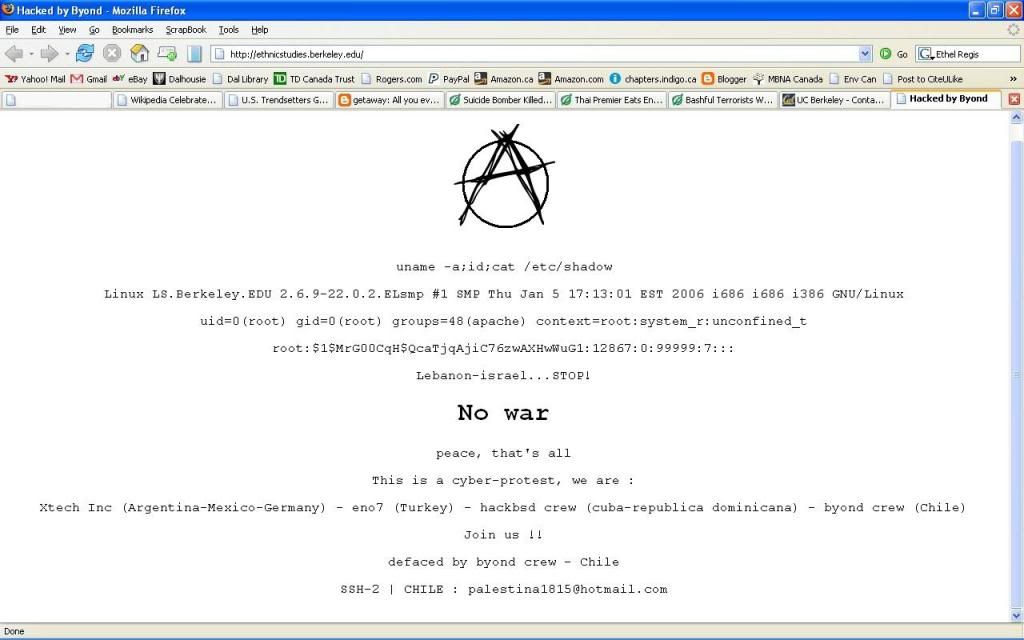Actually, this post is about my adventures online but the original title is catchier.
1. First weird thing: I was downloading something the other night and some guy started hitting on me. This is how our exchange went
Interlocutor: are you really in ns [Nova Scotia]?
Me: why do you ask?
I: i’m in truro [a town in Nova Scotia]
Me: yes i’m in halifax
I: i’m m/40
Me: sorry you’re barking up the wrong tree
I: no i just wanted to talk
Me: sorry anyway, i only use this [program] to dl [download] and don’t like to chat on it
And that was that. Yeah, so maybe he genuinely wanted to talk. What can I say, I was multitasking, I had multiple article PDFs and websites open. I didn’t want to add chatting to my activites otherwise I’d have opened up MSN Messenger. He must have found out where I was by my IP address. I think he thought I was female because my handle had “pink” in it. But I was going by “pinky” after Pinky & the Brain, a cartoon show I used to watch when I was younger. Or he may have thought I was male and wanted to flirt anyway.
On the one hand, this incident shows how being online changes the way people relate to identity. The guy was asking for my gender and my age, something he probably wouldn’t have done if we’d met in person (I look like a twentysomething guy in my picture, right?). Because all he had to go on was my name, the guy (possibly) assumed I was female and started doing the mating dance. I would have had to explicitly tell him my gender for him to get it.
But on the other hand, the incident above also reveals how being online changes nothing at all. The guy immediately declared his age and gender and implicitly asked for mine as well. If he was genuinely interested in just chatting, how relevant would that information have been in reality? Doesn’t the Internet make it so that age and gender don’t matter? Don’t we get to transcend our bodies by being online? Evidently not, since the status of my body (namely, my age and gender) obviously mattered to this guy. A/S/L (age/sex/location) is a common query in chatrooms, so it’s not limited to this one person. Bodies matter, even on the bodiless Internet (though the other person may not have been m/40 anyway, or even just a single person).
This perspective, where the body is seen as the source of identity, mostly comes from feminist theory. In this specific case, I’m drawing upon the work of Lisa Nakamura, whose book Cybertypes: Race, Ethnicity, and Identity on the Internet I’m using quite extensively in my research.
2. Later that night, I went to the University of California at Berkeley’s website to find out more about Ethel Regis, whose work on the Filipino diaspora I read about here. I go over to the page of the Department of Ethnic Studies and find this instead:
Yes, I admit I was reading The Onion while I was working. This was on July 25 at 11:51 PM ADT. It’s puzzling why this crew hacked this particular website. Berkeley is a rather liberal campus, and if anyone is likely to support the Lebanese it’s people from Berkeley. Second, why hack the website of the Ethnic Studies department? A lot of the people there are postcolonial and anti-imperialist thinkers, and they’re even more likely to oppose Israel’s actions in Lebanon. Don’t worry, the website was fine the next day.
Take a look at the countries that the hackers* claimed to be from: Argentina, Mexico, Germany, Cuba, the Dominican Republic, and Chile. They’re all over the place, aren’t they? The Internet is certainly quite good at severing people from the bonds of geography. However, look closer and you’ll realize that all of the countries mentioned are in Latin America, except for Germany. Why are these crews so concentrated in one particular area?
One answer may be language. While the Internet allows users to potentially communicate with anyone else connected to the Internet, the truth is that Internet users are segregated in several different linguistic communities. I’m guessing that these hackers operate mostly in Spanish and they probably met through some kind of Spanish-language space online: a message board, an IRC channel, whatever. Yet another example of how geography is reproduced online.
Notice also that the hackers specifically stated what countries they were from. Why did they do this? What does it matter what country they were from? Does that change their message in any way? It may be that the hackers felt proud to be non-Americans bringing down an American website (though being based in Mexico doesn’t mean you can’t be American too). You see? Nationalist pride exists online, and therefore geography does as well.
3. Someone found my blog by Googling “nova scotia rifle ass”. They ended up on my post about Canada Day, where I mentioned a rifle exactly once. Sorry, I’ve got no analytical insight into this. I’d just like to know what exactly they were looking for.
Anyway, I still haven’t done the post on nationalism and diaspora that I said I’d put up weeks ago, so that is definitely the next thing that’s appearing.
*I know that coders actually prefer these types of programmers to be called crackers, while hackers should be reserved just for really good programmers. But as far as the vast majority of the world is concerned, a hacker is an online vandal and burglar. I defer to the dictatorship of the majority.
